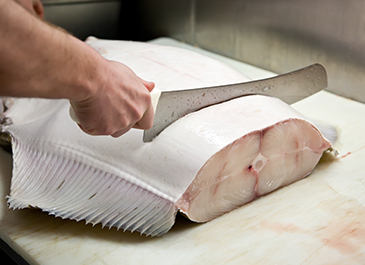When I was initially asked to write something for the Choices newsletter, I thought about several directions I could take. What would be the most useful thing to share about seafood? About Ocean Wise? Ultimately, however, I thought that what I should actually do was cook some fish. Because that’s what this is all about.
Perusing the seafood counter at Choices, I was glad to see several Ocean Wise-recommended options. The Ocean Wise symbol designates seafood that is caught or farmed in a way that is ecologically sustainable—meaning getting it to the dinner table did not seriously impact the environment. Among the Ocean Wise options in front of me: wild sockeye and coho salmon, halibut, Pacific cod, lake trout, Digby scallops, and Dungeness crab. I was quickly seduced by a lovely Pacific halibut steak, which I added to my basket.
In addition to ensuring a seafood product is Ocean Wise, it’s a good idea to consider where it’s from geographically, and remember—or learn—how it fits into the ecosystem. Ocean Wise has created a list of some excellent seafood choices from our local waters to help consumers identify the best options. This makes it easy to choose species from B.C. when they’re in season. That said, maintaining diversity is also important. In the same way we would have a huge ecological footprint if we ate steak for dinner every night, limiting consumption of bigger fish—such as salmon, halibut, and tuna—and eating lower trophic level species—like shellfish and herring—more often is a good plan; halibut should be a special treat.
Unlike all other main proteins that we eat nowadays, most fish are unique in that they were obtained from a wild, natural system. Yet, compared to other types of meat—steak or chicken for example—lots of people have a tougher time picturing fish, both in terms of what it looks like in the wild and also understanding the process by which it ended up on their plate. Thus, an often overlooked aspect of eating seafood is appreciating the fish itself. So, if I’m ever unsure of what the seafood I’m eating actually looks like in the wild, I look it up. In the case of halibut, I’ve long since learned that they are really neat fish: they live on the ocean floor, have both eyes on the same side of their head and they can weigh over 200 kilograms, though as result of fishing, few make it to that weight these days.
I have always believed that eating should be more than just putting food in my mouth and I think that taking the time to think about where my food comes from is especially important in the case of seafood. Not only do I always learn something interesting, but I think I also enjoy the meal a little bit more than I would otherwise.
Laurenne joined the Ocean Wise team as a research analyst in December 2014 after completing her MSc. at the University of British Columbia Fisheries Centre.
Check some of our favorite gluten-free Halibut recipes:
Steamed Halibut and Fennel
Zarina’s Halibut and Curried Coconut Sauce

